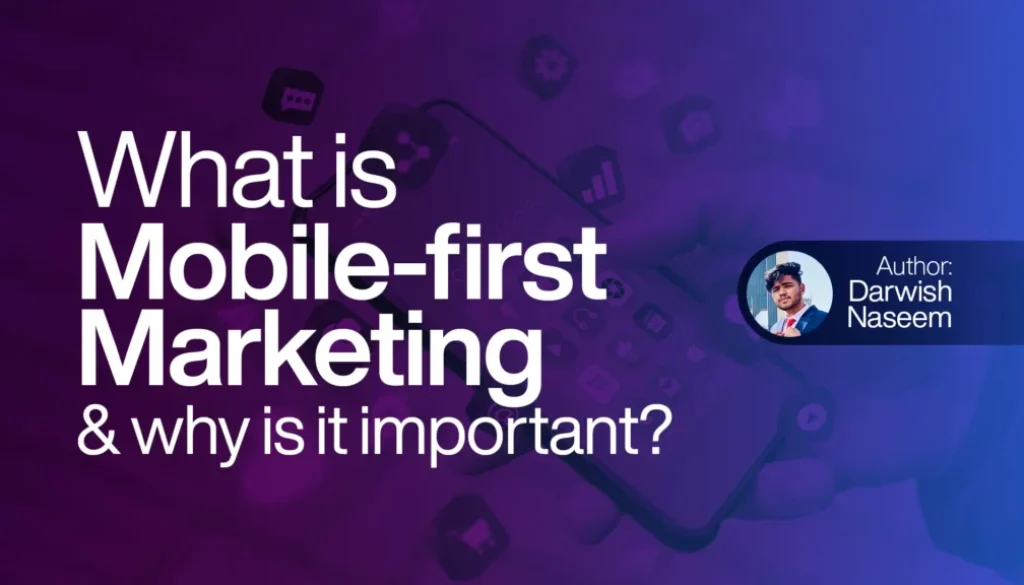What is mobile-first marketing and why is it important?
Mobile-first marketing is the foundation of contemporary client involvement, not just a trendy term. Businesses that disregard mobile optimisation run the risk of becoming irrelevant, as more than 95% of internet users worldwide access the web through mobile devices. Let’s examine the meaning of this tactic and why it is essential for success in the modern era.
Table of Contents
Mobile-First Marketing: What Is It?
Creating websites, advertisements, emails, and content for smartphones and tablets before converting them to PCs is known as mobile-first marketing. Consider it similar to building a house: since most visitors arrive through the front door, you give priority to the mobile experience.
Key features include:
- Speed and simplicity: Mobile users scroll quickly, so content must load fast and communicate value in seconds
- Personalization: Use location data, browsing habits, and device-specific features (like touchscreens) to tailor offers
- Responsive design: Websites and ads automatically adjust to screen sizes, ensuring smooth navigation
Why Does Mobile-First Marketing Matter?
1. Mobile Dominates Online Behavior
People spend 5+ hours daily on smartphones for tasks like shopping, social media, and local searches. A desktop-centric approach alienates this audience.
2. Search Engines Reward Mobile-Friendly Sites
Google prioritizes mobile-optimized sites in rankings. If your site isn’t responsive, it’s buried in search results—even for desktop users.
3. Poor Mobile UX Drives Customers Away
53% of visitors abandon sites that take longer than 3 seconds to load. Tiny buttons, unreadable text, or clunky forms frustrate users and damage brand trust.
4. Local Marketing Thrives on Mobile
“Near me” searches have grown 150% in two years. Mobile-first strategies leverage GPS data to connect users with nearby stores, services, or promotions.
Benefits of Going Mobile-First
- Higher traffic: Mobile-friendly sites rank better, attracting more visitors.
- Better conversions: Simplified checkout processes and bold CTAs (e.g., “Tap to Buy”) reduce friction.
- Stronger brand loyalty: Personalized experiences (like location-based discounts) make customers feel valued.
How to Implement Mobile-First Marketing
1. Optimize Your Website
- Use responsive design tools (e.g., Bootstrap) to ensure seamless screen adaptation.
- Compress images and enable caching to speed up load times.
- Design thumb-friendly menus and buttons—avoid hover effects that don’t work on touchscreens.
2. Create Mobile-Specific Content
- Write short paragraphs with subheadings for easy skimming.
- Use vertical videos (9:16 ratio) and high-contrast visuals for small screens.
- Test content on multiple devices to ensure readability.
3. Leverage Mobile Ads
- Platforms like Instagram and TikTok offer shoppable ads tailored for mobile scrolling.
- Use geofencing to target users near your store with promotions.
4. Prioritize Local SEO
- Claim your Google Business Profile and optimize for “near me” keywords.
- Ensure your site displays click-to-call buttons and maps prominently.
The Bottom Line
It would be like opening a business but shutting the front door if you ignored mobile-first marketing. Fast, user-friendly, and customised mobile experiences must be a top priority for businesses since mobile devices account for the majority of web traffic and purchases. Start by using tools like Google’s Mobile-Friendly Test to evaluate the mobile performance of your website. Then, progressively incorporate tactics like responsive design and hyper-local ads. The outcome? Increased client satisfaction, improved search engine visibility, and a competitive advantage in our small digital world



